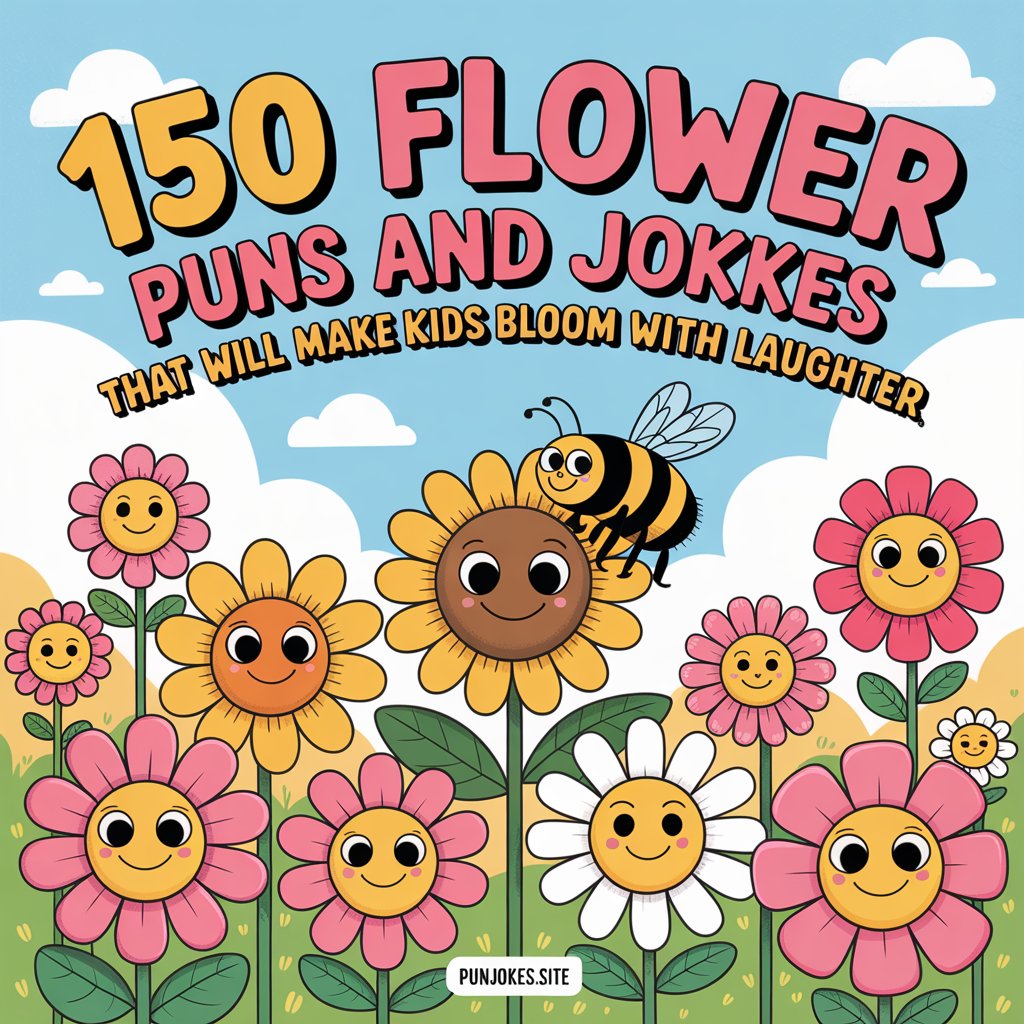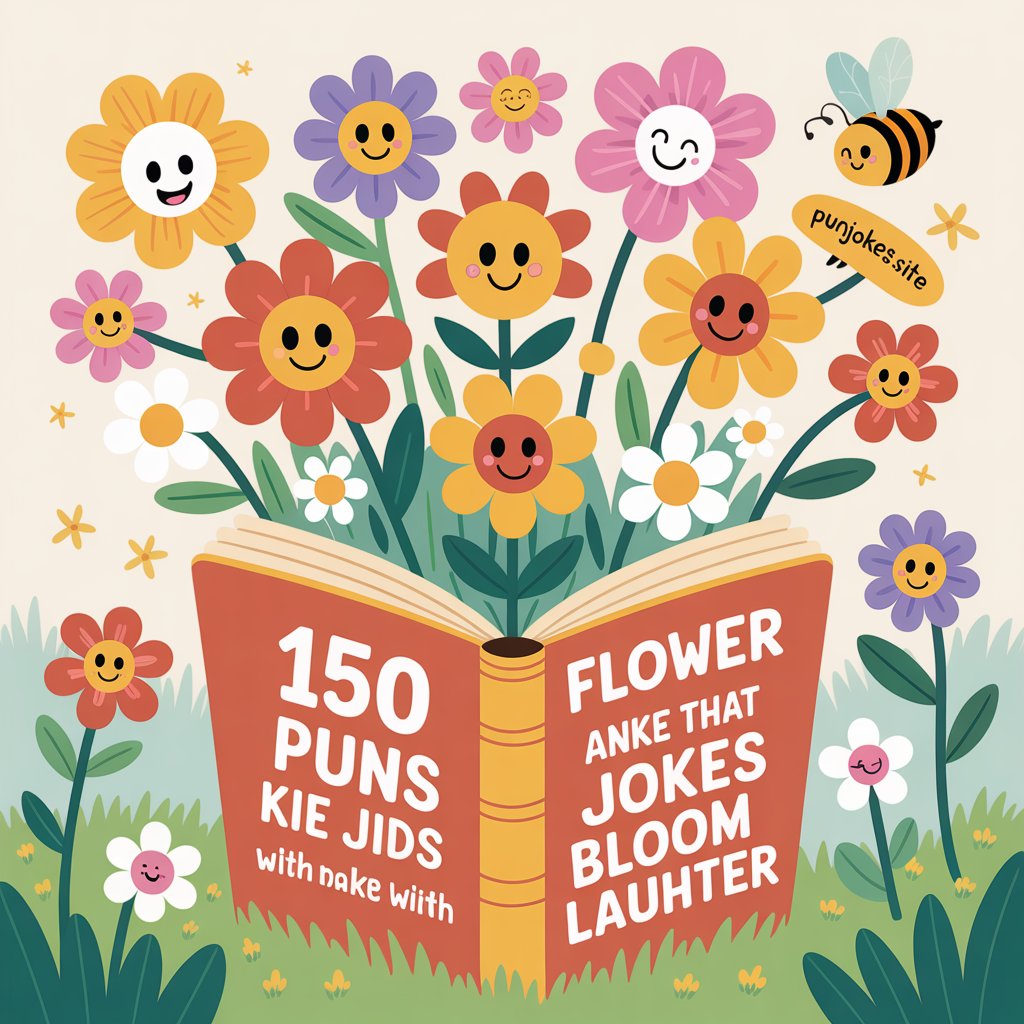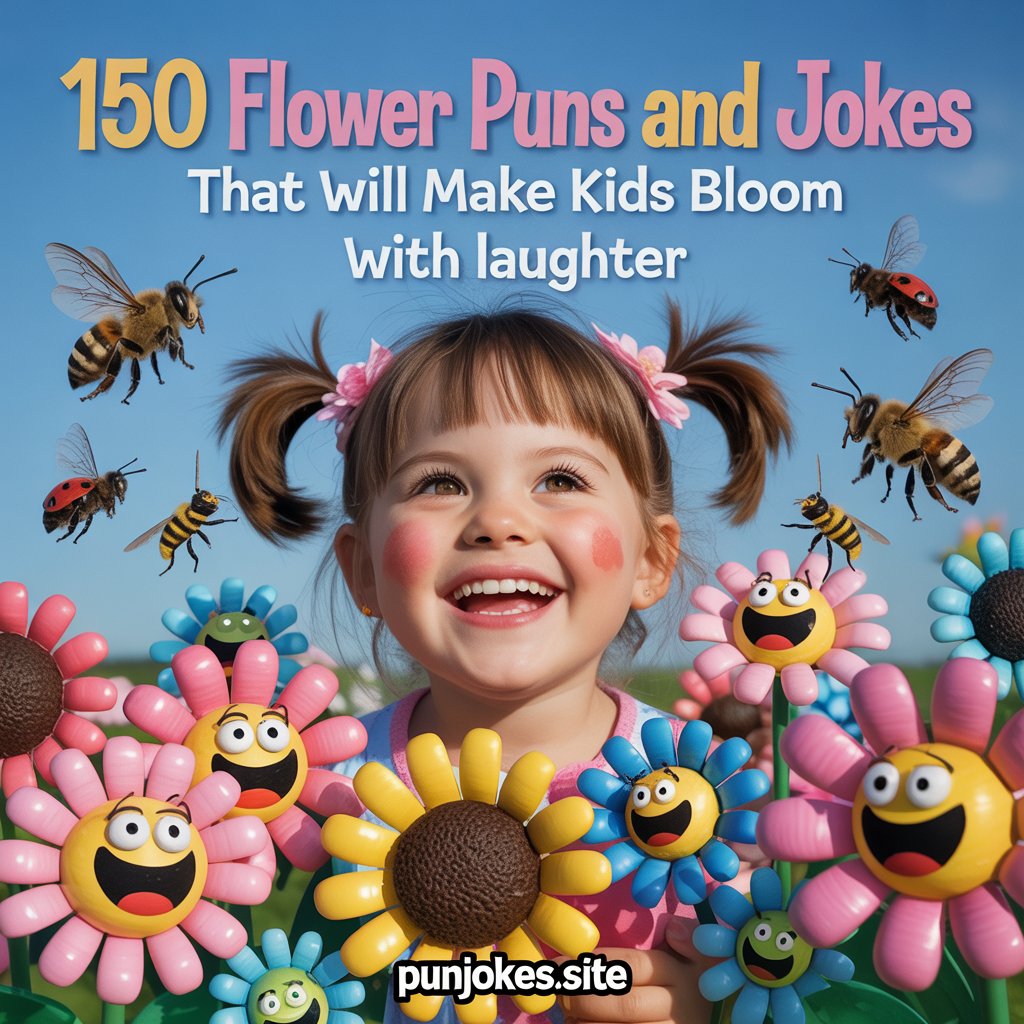Welcome to the garden of giggles! If you’re looking for a bouquet of humor to share with the little ones in your life, you’ve come to the right place. Kids naturally love flowers with their bright colors and sweet scents, but add some wordplay into the mix, and you’ve got a recipe for endless smiles. These flower jokes and puns are perfect for brightening any day, whether you’re a parent, teacher, or just someone who enjoys a good laugh. I’ve planted over 150 flower-themed wisecracks throughout this article, organized to help you find just the right one for any occasion. Each section offers fresh batches of botanical humor that kids will love to share with friends and family. So get ready to dig in—these puns are about to make your sense of humor blossom!
Best Flower Puns and Jokes for Kids Bloom into Laughter
Children have a natural affinity for the silly and unexpected, making flower puns an ideal way to spark their imagination and linguistic development. When kids engage with playful wordplay, they’re actually building important language skills while having fun. The best flower jokes for children combine simplicity with a touch of the absurd, creating moments of surprise that lead to those delightful belly laughs we all love to hear.
These puns work wonderfully as lunchbox notes, classroom ice-breakers, or just spontaneous moments of connection during a nature walk. Many parents report that sharing flower jokes has become a special tradition with their children, creating lasting memories tied to both humor and appreciation for the natural world. Research shows that children who engage with word play regularly develop stronger vocabulary skills and a deeper understanding of language nuances that benefit them throughout their academic journey.
Flower Puns: Blooming with Laughter
Flower puns have been cultivating chuckles for generations because they tap into something we all recognize and appreciate. The beauty of flower-themed wordplay lies in how seamlessly botanical terminology lends itself to humorous double meanings. Words like “bud,” “bloom,” and “grow” easily cross-pollinate between their literal plant meanings and their figurative applications to human experiences. This natural connection makes flower puns accessible even to young joke-tellers who are just starting to understand the concept of plays on words.
What makes these puns especially appealing to kids is the way they transform common garden knowledge into surprising twists. For example, when a child hears “What did the flower say after it told a joke? I was just pollen your leg!” they experience that delightful cognitive shift that happens when two different meanings collide. This mental flexibility is actually good for developing brains, encouraging creative thinking and linguistic connections. Next time you’re looking for a way to brighten someone’s day, try sharing a flower pun—the results will surely be growth-positive!

Flower Jokes: Petal to the Metal Humor
When it comes to flower jokes, the punchlines often rely on clever botanical wordplay that drives laughter forward at full speed. These jokes work because they surprise us by taking familiar flower characteristics and transplanting them into unexpected contexts. Children especially delight in jokes that personify flowers, giving them human-like qualities and problems. Imagine a rose complaining about having too many thorny issues or a sunflower feeling light-headed after looking at the sun too long—these scenarios create instant mental pictures that tickle young imaginations.
The best flower jokes have that “petal to the metal” quality where the humor accelerates quickly to the punchline without getting bogged down in complicated setups. Kids appreciate this directness, as their humor often thrives on immediacy rather than elaborate build-ups. Teachers have found that incorporating garden humor into science lessons about plant life can significantly increase student engagement and information retention. As one elementary school teacher shared, “When I started using flower jokes during our botany unit, I noticed even my most distracted students perking up and participating more actively in discussions about plant anatomy and life cycles.”
Flower Puns for Kids: Garden Variety Giggles
Garden variety giggles sprout naturally when children discover the joy of flower puns tailored just for them. These botanical jokes often work on multiple levels, allowing kids of different ages to find something funny within the same pun. Younger children might simply enjoy the silly sound combinations, while older kids can appreciate the clever wordplay. Parents report that flower puns serve as excellent conversation starters during family walks or visits to botanical gardens, encouraging children to observe and engage with the natural world around them.
Educational psychologists note that humor serves as a powerful memory aid for children, helping them retain information that might otherwise seem dry or uninteresting. When facts about flowers are packaged in the form of jokes and puns, kids are more likely to remember details about different species, growing habits, and plant characteristics. For instance, a simple pun about how daffodils make terrible secrets keepers because they always “trumpet” everything they hear can help children remember the distinctive trumpet shape of daffodil blossoms far better than rote memorization of plant features.
Funny Flower Jokes: Rooting for a Good Time
When kids encounter truly funny flower jokes, they can’t help but root for more, often becoming enthusiastic collectors and sharers of their favorites. These jokes create a special kind of shared hilarity that builds connections between friends and family members. What makes a flower joke truly funny to children often involves elements of surprise, absurdity, or the unexpected personification of plants. The mental image of flowers experiencing human dilemmas—like a cactus afraid of hugs or a wallflower with social anxiety—creates cognitive incongruity that triggers laughter.
Child development experts suggest that humor involving natural elements like flowers helps children develop a positive relationship with the environment. Dr. Maria Greenleaf, a child psychologist specializing in nature connection, explains: “When children associate laughter and joy with plants and flowers, they’re building neural pathways that link positive emotions to the natural world. This early bonding with nature through humor can foster environmental awareness that lasts a lifetime.” This perspective highlights how seemingly simple flower jokes can actually contribute to raising children who value and protect the natural world around them.

Kids’ Flower Puns: A Bouquet of Chuckles
A carefully arranged bouquet of flower puns can provide children with endless opportunities for creative expression and language play. Unlike adult humor, kids’ flower puns tend to embrace the obvious connections with enthusiasm rather than subtlety, finding joy in straightforward associations between plant terminology and everyday situations. For example, telling a friend they look “daisy fresh” or describing a difficult task as “no bed of roses” allows children to experiment with figurative language in accessible ways.
Educational researchers have noted that children who regularly engage with wordplay like flower puns demonstrate stronger literacy development and more positive attitudes toward reading and writing. These linguistic playgrounds give kids permission to experiment with language in low-pressure, high-enjoyment contexts. A study from Columbia Teachers College found that elementary students who were exposed to regular wordplay, including themed puns, scored higher on vocabulary assessments and showed greater comfort with creative writing tasks. The simple act of sharing flower puns may therefore be nurturing not just laughter, but future academic success as well.
Flower Jokes and Riddles: Plantastic Puzzles
Flower-themed riddles add an extra layer of cognitive engagement to the joy of botanical humor, creating plantastic puzzles that exercise children’s problem-solving skills. These brain-teasers often require kids to think laterally, making connections between different meanings of plant-related words or considering flower characteristics in unexpected contexts. For example, “What kind of flowers grow on faces? Tulips (two lips)!” challenges children to hear words differently and make visual associations that stretch their thinking.
These flower riddles serve as excellent mental exercise during car rides, waiting rooms, or anytime you need a screen-free activity that engages young minds. Elementary school counselors have begun incorporating flower jokes and riddles into social-emotional learning programs, noting that the low-stakes problem-solving involved helps children develop resilience and cognitive flexibility. When a child works through the steps to understand why the sunflower couldn’t go to the party (because it was a wallflower), they’re building neural pathways that support creative problem-solving in other areas of their lives.
Easy Flower Puns: Simple Seed of Silliness
Even the simplest flower puns can plant seeds of silliness that grow into genuine appreciation for language play. These easy jokes serve as perfect entry-level wordplay for younger children or those just beginning to understand how puns work. Something as straightforward as “What’s a flower’s favorite type of pickle? A daisy dill!” provides that satisfying moment of connection that helps children grasp how words can have multiple meanings or sound similar yet different. These beginner puns build confidence in linguistic exploration, encouraging children to create their own jokes as they become more comfortable with wordplay.
Parents and educators note that easy flower puns can serve as valuable conversation starters with shy or reluctant speakers. The low-pressure format of sharing a simple joke often helps quieter children find their voice in group settings. Early childhood specialists recommend integrating simple flower puns into everyday activities like gardening, nature walks, or even bath time with floating toy flowers. This casual exposure to wordplay in various contexts helps reinforce the concept that language can be both functional and fun, a realization that supports healthy attitudes toward communication development throughout childhood.

Flower Puns: Sprouting Smiles All Day
The lasting appeal of flower puns lies in their ability to sprout smiles long after they’re first shared. Unlike many other forms of humor that may feel stale upon repetition, garden wordplay tends to maintain its charm even when revisited. Children often adopt favorite flower jokes as part of their personal identity, becoming known as the friend who always has a fresh bloom of humor to share. This special relationship with particular puns helps kids develop their sense of humor as a distinct aspect of their personality.
Psychologists who study child development point out that humor serves important social functions for children, helping them connect with peers, diffuse tense situations, and process complex emotions. Flower puns, with their gentle nature and universal appeal, provide safe material for children to practice these humor skills without risking offense or confusion. As children grow, their appreciation for different types of flower puns evolves, allowing these jokes to “grow” alongside them. What starts as giggling at simple sound-based puns can blossom into appreciation for more sophisticated wordplay, making flower humor a perennial favorite across the childhood years.
Flower Puns One Liners
The art of the one-liner flower pun lies in its efficiency—delivering maximum laughter with minimum setup. These compact jokes pack a powerful pollination punch, often relying on a single clever turn of phrase that creates an immediate smile. Children gravitate toward these brief bursts of humor because they’re easy to remember and share, making them perfect ammunition for the budding young comedian. One-liners like “I’m growing quite fond of gardening—it’s grown on me” or “That florist has arranged everything perfectly” provide instant gratification without requiring the patience of a longer joke structure.
Research in childhood education suggests that brief, memorable jokes serve as excellent linguistic anchors, helping children remember vocabulary words and concepts that might otherwise seem abstract or disconnected from their experiences. Teachers who incorporate flower one-liners into science lessons report that students more readily recall botanical terms when they’re associated with humor. These compact jokes also serve as excellent writing prompts, inspiring children to create their own wordplay and develop confidence in their creative language skills. The accessibility of one-liner flower puns makes them democratic humor tools that children of various verbal abilities can enjoy equally.
Short Flower Puns
Short flower puns thrive on brevity while still delivering that satisfying mental connection that makes wordplay so enjoyable. These compact quips often center around a single floral feature or characteristic, transforming it into an unexpected context that surprises and delights young minds. Phrases like “petal pushers” for enthusiastic gardeners or “stem-ulating conversation” for interesting talks demonstrate how even two-word combinations can create rich linguistic layers for children to unpack and enjoy.
Educators have observed that short flower puns serve as excellent vocabulary builders for children in early reading stages. The condensed format focuses attention on specific word relationships, helping children identify patterns in language more easily than longer, more complex jokes might allow. Language acquisition specialists note that bilingual children particularly benefit from exposure to short puns, as these compact wordplay examples highlight the unique characteristics of English homophones and multiple meanings in an accessible format. For children learning English as a second language, short flower puns provide concrete, memorable examples of how English words can function in flexible and playful ways.
Blossom in Laughter with Flower Puns
When children encounter well-crafted flower puns, they often experience that wonderful moment when understanding blossoms into genuine laughter. This cognitive shift represents a significant developmental milestone in humor appreciation, marking the point where kids can hold multiple meanings in their minds simultaneously. The moment when a child first gets why “A flower’s favorite movie is Petal Pan” is funny represents real intellectual growth—they’ve grasped metaphor, homophonic wordplay, and cultural reference all at once. These moments of blossoming comprehension build confidence in linguistic abilities that extends well beyond joke appreciation.
Parents frequently report that flower puns serve as excellent mood elevators during challenging times or transitions. Whether it’s lightening the mood during a long car ride or easing nervousness on the first day of school, flower jokes provide reliable emotional support through their gentle, accessible humor. Child psychologists recommend maintaining a mental “garden” of age-appropriate flower puns to deploy strategically when children need emotional regulation support. The predictable structure of these jokes, combined with their nature-based imagery, creates a comforting pattern that can help restore emotional equilibrium while still honoring children’s need for levity and joy.
Dual Meanings in Full Punny Flower Puns
The most sophisticated flower puns for children explore dual meanings with playful precision, creating what educators call “full punny” experiences. These jokes rely on words that function meaningfully in both horticultural contexts and everyday situations, creating rich semantic connections that exercise developing brains. When children encounter puns like “The gardener had a budding friendship with his plants” or “The daisy was feeling quite sunny today,” they’re practicing important cognitive skills including semantic flexibility, contextual analysis, and abstract thinking.
Language acquisition researchers have identified that engagement with dual-meaning puns significantly enhances metalinguistic awareness—the ability to think about language as an object of attention rather than just a communication tool. This awareness serves as a foundation for later academic skills including reading comprehension, creative writing, and even second language acquisition. Dr. Elizabeth Chen, a linguistics professor specializing in child language development, explains: “When children work through the mental gymnastics required to understand that ‘rootless’ can describe both a plant without roots and a person without connections, they’re developing neural pathways that support advanced literacy skills and abstract thinking.” These cognitive benefits make flower puns valuable educational tools disguised as simple entertainment.
Petals of Witty-ness & Flower Puns
The most memorable flower puns exemplify genuine wit, showcasing petals of cleverness that children intuitively recognize and appreciate. These sophisticated jokes blend botanical knowledge with linguistic creativity to create moments of surprise and delight that reward children’s growing understanding of both language and the natural world. For example, when kids encounter a line like “The sunflower won the contest because it was outstanding in its field,” they’re processing multiple layers of meaning—the literal image of a tall flower standing in a field and the figurative sense of excellence or achievement.
Education specialists note that exposure to witty wordplay serves as excellent preparation for more advanced literary analysis skills that children will need in later academic settings. The ability to detect and appreciate multiple meanings, implicit connections, and subtle references in flower puns develops the same cognitive muscles used when analyzing poetry, literature, and rhetorical devices. School librarians report that children who enjoy wordplay typically demonstrate greater interest in poetry and figurative language-rich texts. This connection highlights how something as seemingly simple as sharing flower puns can lay groundwork for sophisticated literary appreciation that serves children throughout their educational journey.
These flower puns and jokes offer more than just laughs—they provide valuable opportunities for language development, cognitive growth, and emotional connection. Whether you’re a parent looking for lighthearted activities to share with your children or a teacher seeking ways to make learning more engaging, this collection offers something for everyone. The beauty of flower humor lies in its accessibility across ages and its ability to grow alongside children’s developing understanding of language. So go ahead and plant these jokes in young minds—you’ll be amazed at how quickly they take root and blossom into even more creative wordplay. Remember that laughter, like flowers, is something we can never have too much of in our lives!
Conclusion: Let Your Humor Blossom with Flower Puns
The garden of flower puns we’ve explored together provides endless opportunities for growing connections with the children in your life. These botanical jokes do much more than simply entertain—they nurture important cognitive development and language skills while creating memorable moments of shared laughter. As we’ve seen throughout this collection, flower puns work on multiple levels, allowing children of different ages and developmental stages to find something that resonates with their particular sense of humor.
Research consistently shows that wordplay serves as a powerful tool for fostering linguistic flexibility and creative thinking in young minds. When children engage with flower puns, they’re exercising mental muscles that will serve them well throughout their academic journey and beyond. The ability to recognize multiple meanings, make unexpected connections, and appreciate the playful nature of language represents valuable skills that transfer to reading comprehension, creative writing, and even social interactions. Perhaps most importantly, these jokes plant seeds of joy in childhood that can blossom into lifelong appreciation for both language and nature.
Frequently Asked Questions About Flower Puns for Kids
What age group are flower puns best suited for?
Flower puns can be enjoyed by children across a wide age range, though their appreciation will differ developmentally. Preschoolers (ages 3-5) typically enjoy simple sound-based flower jokes that rely on rhyme or alliteration. Elementary school children (ages 6-10) begin to appreciate wordplay mechanics and can understand more complex puns involving dual meanings. By middle school (ages 11-13), children often develop sophisticated humor appreciation and may enjoy creating their own flower puns. The beauty of this type of humor is that it can “grow” alongside children, offering new layers of appreciation as their linguistic understanding develops.
How can parents use flower puns to support language development?
Parents can leverage flower puns as effective tools for boosting vocabulary and language skills. Try incorporating age-appropriate puns during nature walks, gardening activities, or while looking at picture books featuring plants and flowers. Point out the multiple meanings that make the pun work, helping children recognize the cognitive connection. Encourage children to create their own flower puns as they become comfortable with the concept. This creation process strengthens word relationships in developing brains and builds confidence in language manipulation. Many parents report that starting a “family pun journal” where everyone contributes flower jokes becomes a treasured keepsake that documents language development over time.
Can flower puns help children who struggle with reading or language processing?
Yes! For children with reading challenges or language processing difficulties, flower puns can serve as engaging, low-pressure tools for building linguistic connections. The visual nature of many flower jokes (imagining a “daisy chain” of events or a “budding romance” between characters) creates memorable mental images that can help bridge language processing gaps. Speech-language pathologists often incorporate themed wordplay into therapy sessions because the emotional engagement of humor helps maintain attention and motivation. The predictable patterns in many flower puns provide scaffolding for children who benefit from structure in language learning. Parents of children with dyslexia, language processing disorder, or other literacy challenges report that humor often provides a breakthrough moment where language suddenly feels accessible and enjoyable rather than frustrating.
How can teachers incorporate flower puns into educational settings?
Teachers across grade levels have found creative ways to integrate flower puns into their curriculum, particularly in science, language arts, and social-emotional learning. During botany units, plant-based wordplay can help students remember anatomical terms and life cycle stages. Language arts teachers use flower puns as examples when teaching about figurative language, metaphor, and multiple meanings. Some effective classroom applications include:
- Creating illustrated pun dictionaries as class projects
- Using flower puns as morning meeting warm-ups
- Incorporating jokes into nature journals or science notebooks
- Designing “pun hunts” during garden or park field trips
- Using flower puns as prompts for creative writing exercises
Teachers report that humor integration increases engagement and information retention across subject areas.
Why do some children struggle to understand flower puns?
Some children may find puns challenging due to developmental factors or specific learning differences. Understanding wordplay requires cognitive flexibility—the ability to hold multiple meanings in mind simultaneously and switch between them. This skill develops gradually throughout childhood, with significant individual variation. Children with autism spectrum disorder or certain language processing differences may interpret language more literally, making the figurative aspects of puns difficult to access. For English language learners, cultural context and vocabulary knowledge may present additional challenges. Parents and educators can support these children by explicitly explaining the dual meanings that create the humor, using visual supports, and celebrating incremental understanding rather than expecting immediate laughter.
What are the social benefits of sharing flower puns with kids?
Beyond cognitive development, flower puns offer significant social advantages for children. Sharing jokes creates bonds between family members and peers while teaching important conversational timing and audience awareness. Learning to deliver a pun effectively helps children understand social cues, voice modulation, and the back-and-forth rhythm of engaging interactions. Humor also serves as a valuable social currency among children, giving those with a good repertoire of jokes confidence in group settings. Counselors and social skills specialists often use structured joke-sharing as a tool for helping children practice conversational skills in a predictable, enjoyable format. The relatively gentle, inoffensive nature of flower puns makes them particularly suitable for developing these social skills without risk of causing upset.
















